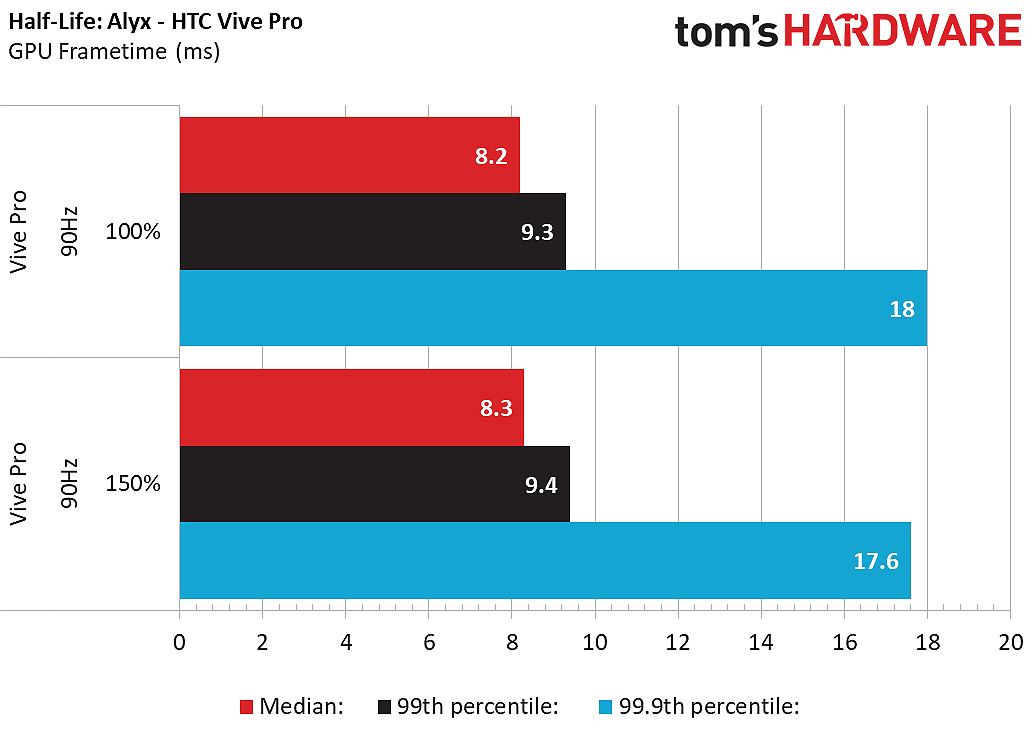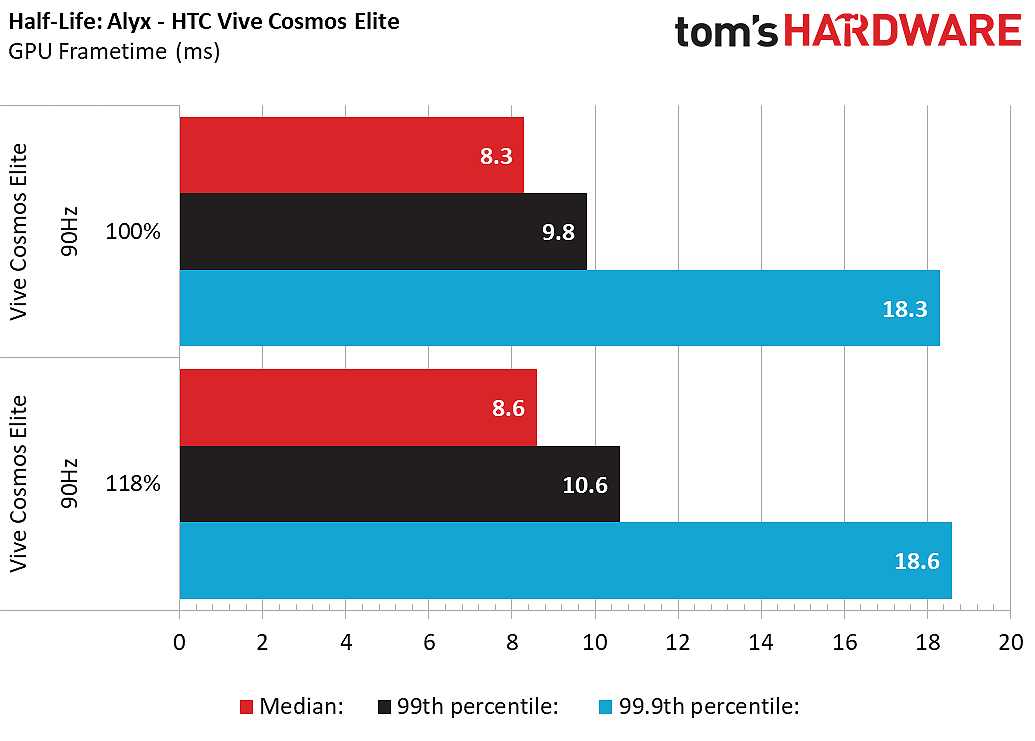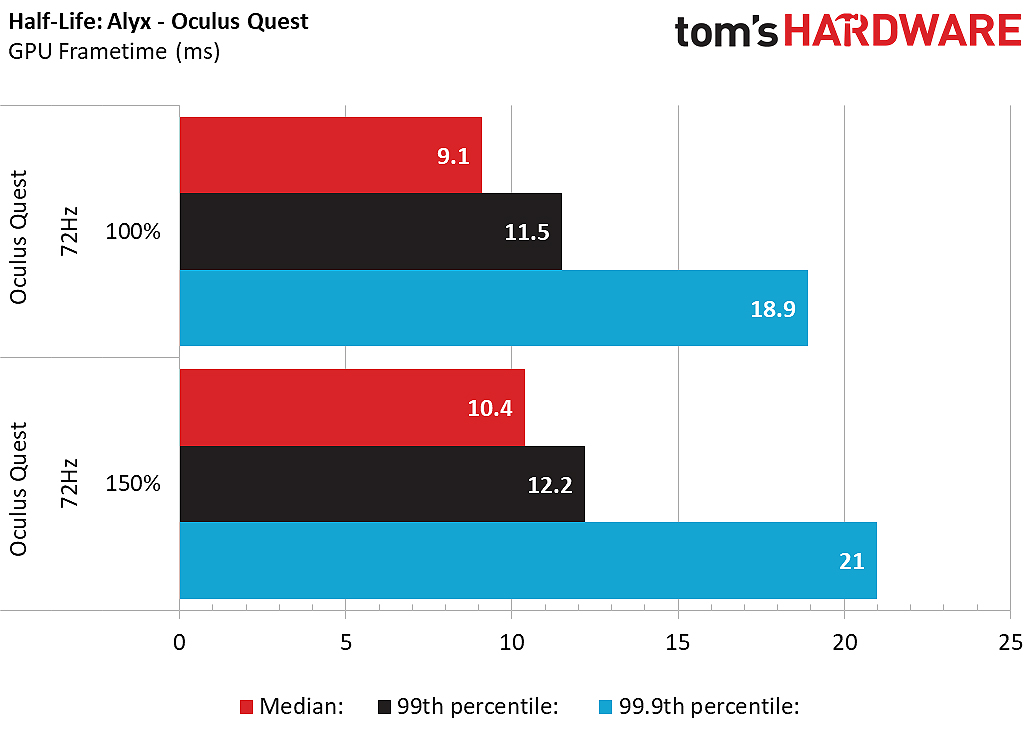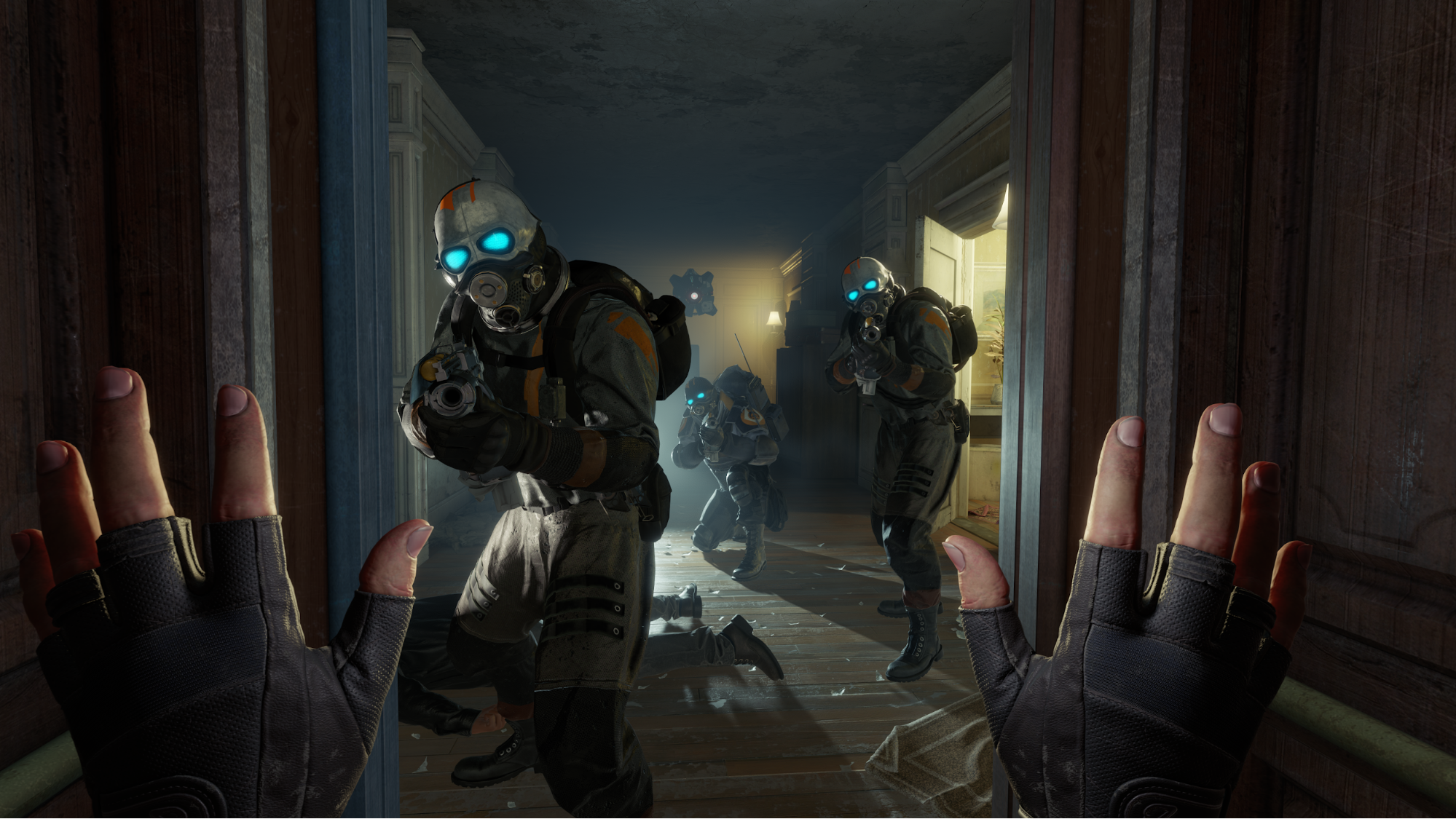Why you can trust Tom's Hardware
Half-Life: Alyx: Gameplay Benchmarks

Test Setup
Half-Life: Alyx is supposed to be a watershed moment for the VR market, so we pulled out all the stops to test it. We put the game to the test in eight different headsets, with four different controller options, three different locomotion settings and three different position configurations. Put simply, we did a whole lot of testing to figure out which combination will give you the best experience in Half-Life: Alyx.
The headsets that we tested include Valve’s Index headset (with the screen set to refresh rates of 90 Hz and 120 Hz); HTC’s full lineup of Vive headsets, including the original HTC Vive, the HTC Vive Pro and the HTC Vive Cosmos Elite, the Oculus Rift, Oculus Rift S and Oculus Quest and a Pimax 5K Plus. Half-Life: Alyx also supports Windows MR headsets, but we didn’t have one of those on hand to test.
All tests were performed on our VR test rig to capture our benchmark results. It includes an Intel Core i7-8700K CPU, 16GB of DDR4-3666 RAM and an Nvidia GeForce RTX 2080 Founders Edition graphics card.
For these tests, we set the rendering resolution to auto to allow SteamVR to dictate the rendering quality. Theoretically, this should balance the performance we achieve on each headset. We also tested each headset at 100% resolution for a comparison.
Half-Life: Alyx on Valve Index






Valve’s Index headset was built alongside the development of Half-Life: Alyx. As such, it shouldn’t come as a surprise that the Index is one of the best headsets for playing the game.
The display offered incredible visual quality, and the speakers on the Index really complimented the impressive audio profile of the game.
Half-Life: Alyx worked excellent with the displays running at 90 Hz, but 120 Hz made the action feel a bit smoother. I also noted that continuous locomotion felt better at a higher refresh rate.
Get Tom's Hardware's best news and in-depth reviews, straight to your inbox.
The Index controllers are also fully supported, including finger animations tied to the capacitive sensors in the controller.
Half-Life: Alyx on HTC Vive



The HTC Vive has been around for four years now, so it’s getting a bit long in the tooth. However, there’s no reason you can’t enjoy Half-Life: Alyx on this device. Your visual experience won’t be as good as it would on a newer device. Still, the lower resolution could be countered to some degree by supersampling the game to improve the output resolution without a significant performance hit.
Half-Life: Alyx on HTC Vive Pro



The Vive Pro offered a remarkably similar experience to the Index headset when it came to Half-Life Alyx’s visual quality, but the audio quality left a lot to be desired. In many games, the inferior speakers in the Vive Pro don’t make a meaningful difference to your gaming experience; however, the music and the sound effects in Half-Life: Alyx suffered on this headset.
Half-Life: Alyx on HTC Vive Cosmos Elite



Half-Life Alyx didn’t fully support the standard HTC Vive Cosmos headset at the beginning of our test period. However, the Vive Cosmos Elite version, which uses an external tracking faceplate and base stations, were supported.
The early build of the game did not yet have support for the standard Cosmos controllers. The version of the game that will ship on March 23 and features full support for the camera-tracked Cosmos controllers.
Half-Life: Alyx on Pimax 5K Plus






Valve doesn’t officially support the Pimax 5K Plus headset. The device is a SteamVR head-mounted display (HMD), so it is compatible with the platform, but the development team did not optimize Half-Life: Alyx for this HMD. That said, the game works just fine on the Pimax5K+ with the right settings.
I tested the game with the Wide, Normal field of view (FOV) configurations. At first, I noticed assets popping in and out of the scene at the far right edge of my field of view.The game ran fine otherwise, but I did find the phenomenon quite distracting. Enabling compatibility with parallel reprojections in the Pitool software fixed the issue.
Pimax is offering a bundle of the 5K Plus with Half-Life: Alyx included (as well as a bundle with the 5K XR).
Half-Life: Alyx on Oculus Rift



The Oculus Rift is another older headset that works fine with Half-Life: Alyx. Valve even took into consideration that most Rift owners don’t have a room-scale setup, so it optimized the game for forward-only playspace configurations.
Half-Life: Alyx on Oculus Rift S



The Rift S is an excellent headset for playing Half-Life: Alyx. Valve did a great job mapping the controls on the Oculus Touch controllers, so the inputs are almost the same as the inputs for the Index controllers.
The Rift S has a lower refresh rate than most other VR headsets, but that didn’t appear to have any adverse effect on gameplay.
Half-Life: Alyx on Oculus Quest



The Oculus Quest through Oculus Link was the worst configuration that we tested, but that’s not to say that the experience was terrible. The refresh rate in the Quest is limited to 72 Hz, which was apparent when switching rapidly between headsets, but it didn’t appear to affect gameplay significantly.
The biggest issue with playing Half-Life: Alyx on the Quest was the degraded visual quality. The compression and decompression processes worked well, but PC-connected headsets don’t need to receive compressed signals, so you get better color and sharpness.

Final Thoughts
I’ve been playing Half-Life: Alyx for a week now. Often when I get a game for testing, I don’t spend a lot of time playing the game when I’m not testing a headset: Half-Life: Alyx is different. I will definitely be spending far more time in this world in the coming weeks. I’m no longer slack-jawed when I hope into this world anymore but I am still enamored by the experience.
VR already has some games that can be considered AAA titles, such as The Walking Dead: Saints and Sinners and Asgards Wrath, and I’ve played my share of VR games over the years. I can say pretty confidently that Half-Life: Alyx is my favorite one so far. I’m torn over Steam’s $60 list price, but Half-Life: Alyx is a must-have for any VR shooter or horror fan.
Kevin Carbotte is a contributing writer for Tom's Hardware who primarily covers VR and AR hardware. He has been writing for us for more than four years.
-
SteveRNG I'm confused by the Oculus Quest comments.Reply
The biggest issue with playing Half-Life: Alyx on the Quest was the degraded visual quality. The compression and decompression processes worked well, but PC-connected headsets don’t need to receive compressed signals, so you get better color and sharpness.
... but I think I've got i now.
I'm assuming the only way it works with the Oculus Quest is if it is connected to a PC via the USB C connection. You state "PC-Connected headsets don't need to receive ...". Are you talking about all other PC-Connected headsets? Or are you actually playing the game wirelessly without the USB connection to the PC? -
kcarbotte ReplySteveRNG said:I'm confused by the Oculus Quest comments.
The biggest issue with playing Half-Life: Alyx on the Quest was the degraded visual quality. The compression and decompression processes worked well, but PC-connected headsets don’t need to receive compressed signals, so you get better color and sharpness.
... but I think I've got i now.
I'm assuming the only way it works with the Oculus Quest is if it is connected to a PC via the USB C connection. You state "PC-Connected headsets don't need to receive ...". Are you talking about all other PC-Connected headsets? Or are you actually playing the game wirelessly without the USB connection to the PC?
Quest is a standalone headset so it normally runs its own android-based software. You can plug it into your PC with a USB cable to operate it as a tethered headset like the rest that I tested.
I was not using the wireless streaming feature as that's not an officially supported option.
My comments were in comparison to the other headset in the roundup. For example, the Rift S has lower resolution and LCD displays verses the higher res OLED in the quest, but it still looks better in the Rift S. -
SteveRNG Replykcarbotte said:Quest is a standalone headset so it normally runs its own android-based software. You can plug it into your PC with a USB cable to operate it as a tethered headset like the rest that I tested.
I was not using the wireless streaming feature as that's not an officially supported option.
My comments were in comparison to the other headset in the roundup. For example, the Rift S has lower resolution and LCD displays verses the higher res OLED in the quest, but it still looks better in the Rift S.
Understood. Thank you! -
shrapnel_indie It's a disappointment that it is only VR. It puts it's entry level on par with Crysis with it's high hardware demands when it was released. Not everyone is ready or willing to invest in VR still. (Some just have medical issues.)Reply
AND... IT'S NOT HALF-LIFE 3 :) -
drtweak SSTTAAAPPPP!!! You're making me want to spend $500 bucks in a time like this right now on a VR headset to play this game!!! My wife will kill me! HAHAReply -
woot <Mod Edit> valve, first they leave us with a 13 year cliffhanger, then they make a hl game for VR only.....fork out 600-1000$ just to play one game....i wonder what stopped them from making this game compatible only with index vr?Reply -
Achoo22 Very disappointing that it wasn't tested with WMR. WMR arguably has the worst tracking of all PCVR and sometimes results in very different experiences (melee in Saints & Sinners, for example). Things like being forced to throw things to yourself with the gravity gloves feel totally different and it changes the complexion of the accessibility options when you realize that there's no way to simplify the action.Reply -
digitalgriffin Replywoot said:<Mod Edit> valve, first they leave us with a 13 year cliffhanger, then they make a hl game for VR only.....fork out 600-1000$ just to play one game....i wonder what stopped them from making this game compatible only with index vr?
Back in 1998, people were buying two Voodoo 2's for $300/pop. That's $476/pop in today's dollars.
It's the next mega upgrade wave that will grow in similar fashion to 3D accelerator adoption back then. And apps like this and Asgard's wrath, and entry systems at $400, will make the VR trend pass the tipping point IMHO.
The only thing holding it back is acceptance. Some people will just refuse to put on a helmet, because they feel silly. Kids have no such hangups (if you ever watch them line up for VR at arcades.) It feels silly till you try it. -
woot Replydigitalgriffin said:Back in 1998, people were buying two Voodoo 2's for $300/pop. That's $476/pop in today's dollars.
It's the next mega upgrade wave that will grow in similar fashion to 3D accelerator adoption back then. And apps like this and Asgard's wrath, and entry systems at $400, will make the VR trend pass the tipping point IMHO.
The only thing holding it back is acceptance. Some people will just refuse to put on a helmet, because they feel silly. Kids have no such hangups (if you ever watch them line up for VR at arcades.) It feels silly till you try it.
No doubt that VR is most likely the next big thing in gaming, however i think whats holding it back is affordability, a good VR headset costs roughly as much as a decent gaming rig, also consider human rationale, if someone is going to jump onto a fad, they will most likely want the best experience possible.
Convince me what valve isn't just hawking their VR headset, couldn't've they made a non VR version?